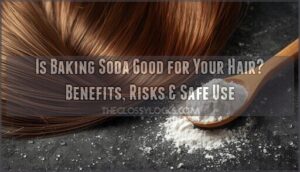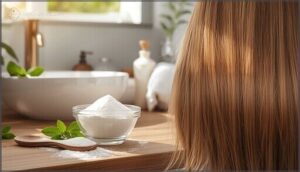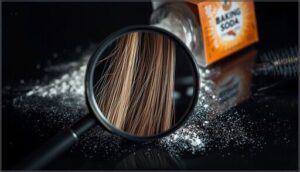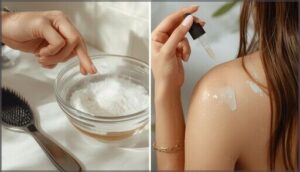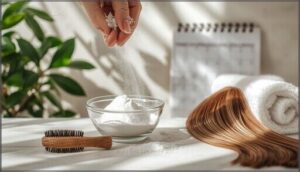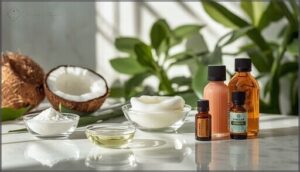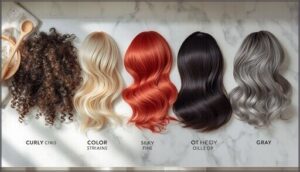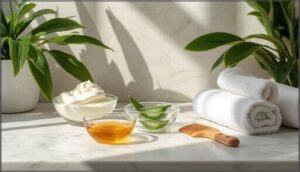This site is supported by our readers. We may earn a commission, at no cost to you, if you purchase through links.
Every head of hair tells its own story, but sometimes—despite your best efforts—grease, buildup, and dullness steal the spotlight. Maybe you’ve scrolled through “natural” remedies and landed on baking soda, catching whispers of its power to strip away the bad and bring back your shine.
Is baking soda good for your hair, or does that glimmering promise hide some less-than-glamorous consequences? The answer isn’t black and white. Regarding something as personal and variable as hair, understanding what baking soda does beneath the surface makes all the difference.
Table Of Contents
- Key Takeaways
- Is Baking Soda Good for Your Hair?
- Benefits of Baking Soda for Hair
- Risks and Drawbacks of Baking Soda
- How to Use Baking Soda Safely on Hair
- Alternatives to Baking Soda for Hair Care
- Frequently Asked Questions (FAQs)
- How often should I use baking soda on my hair?
- What are some alternatives to baking soda for hair care?
- Is baking soda safe to use on colored hair?
- Does baking soda affect hair growth or loss?
- Can baking soda remove hair dye or color?
- Is baking soda safe for children’s hair care?
- Can baking soda help with scalp odor issues?
- Conclusion
Key Takeaways
- Baking soda can strip away oil and product buildup from hair, but its high pH easily disrupts your scalp’s natural balance.
- Using baking soda too often leads to dryness, breakage, frizz, and color fading, especially on sensitive or chemically-treated hair.
- Safer alternatives like clarifying shampoos, apple cider vinegar rinses, and natural oils achieve similar cleansing with fewer side effects.
- If you decide to try baking soda, limit usage, dilute it well, patch-test, and always follow with a moisturizing treatment.
Is Baking Soda Good for Your Hair?
Baking soda’s track record as a hair care remedy is mixed at best. While it can remove buildup and clarify your scalp in the short term, its high pH creates real risks for your hair’s structure and health.
Let’s look at what baking soda actually does to your hair and how people generally use it.
Overview of Baking Soda’s Effects
Baking soda benefits for hair—like removing buildup—come with serious drawbacks. Its chemical composition creates a pH imbalance, jumping from your scalp’s natural 5.5 to 9. This alkalinity opens hair cuticles, triggering cuticle damage, moisture loss, and potential hair damage. Scalp irritation often follows, especially with repeated use.
The long-term effects of baking soda on hair include increased breakage and weakened structure, making its impact more harmful than helpful for most people. It can also clarify the scalp by removing excess oil.
Common Uses in Hair Care
Despite its risks, you’ll still find baking soda in several haircare practices. The “No Poo Method” popularized this DIY hair cleanser after 2010, especially among younger eco-conscious users. Here’s how people use it:
- Product buildup removal through weekly clarifying rinses (52% of users have oily hair)
- Scalp exfoliation to address flakiness and dandruff
- Hair oil and buildup removal from heavy styling products
- Natural haircare alternative mixing 1 tablespoon per cup of water
- Hair cleansing and product buildup treatments before deep conditioning
Because of its high pH, baking soda can provide a deep clean.
Benefits of Baking Soda for Hair
Baking soda has gained popularity in natural hair care circles, largely because it can tackle certain scalp and hair issues without the use of commercial products. While it’s not a miracle solution, it does offer a few notable benefits when used correctly and sparingly.
Here’s what baking soda can actually do for your hair.
Removing Oil and Product Buildup
When styling products and natural sebum accumulate on your hair, baking soda’s alkaline properties work to dissolve these layers through oil disruption and buildup dissolving. Its detergent-like action breaks down residues that standard clarifying shampoos target, facilitating residue removal while promoting scalp cleanliness. This process can restore shine lost to product buildup, though results depend on proper hair cleansing techniques.
| What Baking Soda Removes | How It Works |
|---|---|
| Styling Product Residue | Alkaline pH dissolves chemical layers |
| Natural Sebum & Oils | Disrupts oil bonds on hair shaft |
| Environmental Dirt | Physical and chemical breakdown |
Clarifying The Scalp
Beyond removing product residue, you’ll find that baking soda’s high pH around 9 temporarily neutralizes your scalp’s natural acidity, which sits between 4.5 and 5.5. This pH balance impact creates an environment less favorable for bacterial and fungal growth, offering scalp buildup removal benefits.
While clarifying shampoos achieve similar results more gently, baking soda benefits include this deep-cleansing effect—though usage best practices demand caution to prevent stripping protective oils.
Exfoliating Dry Scalp
As a physical exfoliator, baking soda’s mildly abrasive texture helps you tackle dry scalp concerns by lifting away dead skin cells that contribute to flakiness. This scalp exfoliation benefits your hair follicles by unclogging pores and improving circulation.
When considering this DIY scalp care approach for dry scalp relief, keep these baking soda scrub essentials in mind:
- Limit exfoliation frequency to once weekly maximum
- Mix with water to form a gentle paste
- Apply with fingertips, not nails
- Rinse thoroughly to prevent residue buildup
- Follow with moisturizing conditioner to combat potential dryness
Temporary PH Adjustment
When you apply baking soda, its alkaline nature temporarily neutralizes scalp acidity, shifting your pH balance from its natural 4.5-5.5 range toward a more alkaline state. This temporary disruption effects cuticle layer swelling, which may reduce microbial growth by creating an inhospitable environment for bacteria and fungi.
However, neutralizing scalp acidity compromises your acid mantle—your skin’s protective barrier that maintains ideal scalp health.
Risks and Drawbacks of Baking Soda
While baking soda can temporarily clean your hair, it comes with some serious trade-offs that you need to know about. The same properties that strip away buildup can also damage your hair’s structure and irritate your scalp.
Let’s look at the main risks you’re taking when you use baking soda as a hair treatment.
Hair and Scalp Dryness
Baking soda’s high alkalinity—pH of 9 compared to your scalp’s natural 5.5—disrupts pH balance and strips essential oils, triggering dryness and scalp sensitivity. This oil stripping compromises moisture retention, leaving your hair dull and your scalp vulnerable to irritation. Frequent use can worsen:
- Chronic scalp dryness and flaking
- Reduced scalp resilience
- Persistent itchiness
- Hair dullness and loss of shine
Disrupted pH balance fundamentally weakens your scalp’s protective barrier, increasing hair breakage risk.
Damage From High PH Levels
High pH levels in baking soda force your hair cuticles to swell and lift, allowing moisture to escape and causing structural weakening. This pH imbalance disrupts your hair’s protein bonds—the framework that holds each strand together—leading to cuticle damage and hair weakening.
The impact of pH on hair health is significant: alkaline products generate static buildup and friction between strands, compounding baking soda drawbacks and compromising your hair pH balance.
Breakage and Frizz
Ever wonder why frizz and breakage pop up after “natural” remedies? When you use baking soda, you rough up the hair cuticle, leaving hair fibers exposed and brittle—think tiny splinters along each strand.
Using baking soda on hair leaves cuticles rough and exposed, causing brittle strands, frizz, and breakage
This weakens elasticity, disrupts hair porosity, and drains moisture, causing frizz and breakage. Smart preventative measures start with gentle care, not harsh scrubs.
Risks for Colored or Sensitive Hair
Imagine your fresh hair color fading too soon, or a tingly scalp turning fiery—baking soda can do both. Its high pH causes cuticle damage, accelerates hair color fading, and strips dye right out.
For sensitive scalps, it may spark scalp inflammation or eczema flare-ups. Chemically processed or colored hair is especially at risk from this harsh homemade approach.
How to Use Baking Soda Safely on Hair
If you’re curious about trying baking soda on your hair, a little care goes a long way. It’s important to approach this method with a few safety tips in mind.
Let’s break down what you need to know before you get started.
Proper Dilution and Application Methods
With using baking soda for hair, precision is your best ally. The right Mixing Ratios and water temperature make all the difference.
For safe application technique, always dissolve baking soda fully in warm water, spread evenly on wet hair, and rinse thoroughly.
Patch testing on your skin safeguards against irritation—a smart move for sensitivity assessment before full use.
Frequency and Moderation Guidelines
Once you’ve nailed your proper mixing and patch test, keep your frequency in check. Weekly limits are key—especially if you have oily hair.
For dry hair or scalp sensitivity, spacing out use means less risk of long-term damage.
Using baking soda for hair care should remain an occasional step, not a habit, so your hair pH balance stays in line.
Combining With Other Natural Ingredients
Spacing treatments helps maintain your scalp’s balance, but for extra care, try blending baking soda with apple cider vinegar, aloe vera, coconut oil, or essential oils. These combinations—each with ACV benefits, Coconut hydration, Aloe soothing, and Essential enhancement—add moisture, comfort, or shine while supporting recipe safety:
- Coconut oil: hydration and frizz control
- Aloe vera: soothing dry skin
- Apple cider vinegar: restores shine
- Essential oil: antibacterial boost
Precautions for Different Hair Types
Each hair type—curly hair, fine hair, color-treated, oily scalp, or gray hair—faces unique risks with baking soda: dryness in curls, limpness in fine strands, color fading for treated hair, and fragility in older or oil-prone hair. Here’s a quick guide:
| Hair Type | Main Risk | Usage Tip |
|---|---|---|
| Curly hair | Frizz, breakage | Avoid or use rarely |
| Fine hair | Dullness, static | Deep-condition after use |
| Color-treated | Fading, brittleness | Best to avoid completely |
| Oily scalp | Irritation, rebound oil | Limit to once a week |
| Gray hair | Dryness, fragility | Monthly max, extra moisture |
Alternatives to Baking Soda for Hair Care
If baking soda isn’t quite right for your hair, there are other ways to keep your scalp feeling fresh and clean.
Some options are gentle, while others are made for deeper cleansing. Let’s look at a few alternatives you might want to try.
Clarifying Shampoos
Ever felt like your hair needs a reset after days of products and grit? Clarifying shampoos are the market’s rising stars, driven by demand for effective buildup removal and evolving usage habits. They tackle stubborn product buildup better than baking soda.
Look for:
- Sulfate-free options for gentler cleansing
- Strong brand performance in expanding markets
- Awareness of safety concerns, especially for dry or colored hair
Apple Cider Vinegar Rinses
Unlike baking soda, apple cider vinegar (ACV) offers a gentle approach to restoring pH balance. With its acidic profile and antimicrobial properties, ACV rinses can add shine, smooth frizz, and help clarify the scalp—provided you dilute it properly.
Application guidelines include mixing 2–4 tablespoons ACV with 16 ounces water, avoiding direct use to reduce risks, especially for sensitive hair types.
Natural Oils and Scalp Treatments
For a gentler route to scalp health, natural oils—like coconut oil, tea tree oil, and argan—form protective barriers, locking in moisture and supporting Scalp Hydration.
Clinical data backs their Oil Efficacy for Hair Growth, elasticity, and Sebum Regulation.
Rich treatments nourish and soothe, making scalp treatment routines both effective and restorative, particularly for anyone sidestepping baking soda.
Recommendations From Hair Professionals
Imagine letting a hair stylist peek into your routine—what would they say? Hair care professionals urge you to skip baking soda and embrace professional alternatives for most needs. Here’s what stands out in hair care recommendations from stylists:
- Use clarifying shampoos sparingly
- Pick pH-balanced, sulfate-free cleansers
- Avoid harsh products
- Prioritize sensitive hair needs
- Consult on color-treated hair
Frequently Asked Questions (FAQs)
How often should I use baking soda on my hair?
If you’re wondering about usage frequency, using baking soda for hair care is best limited to once a week or less.
Your hair texture and scalp sensitivity play big roles—adverse reactions rise with frequent use, so professional advice helps.
What are some alternatives to baking soda for hair care?
Alternatives to baking soda for hair include clarifying shampoos, sulfate-free shampoos, herbal cleansers, scalp scrubs, oil treatments, natural shampoo, and apple cider vinegar rinses.
Professional advice often favors these natural hair care alternatives for gentle, effective cleansing.
Is baking soda safe to use on colored hair?
Picture a watercolor painting slowly washed out by rain; baking soda acts much the same on color-treated hair, accelerating color fading and cuticle damage, leading to dryness.
Professional opinions strongly recommend alternative products for managing dry and colored hair.
Does baking soda affect hair growth or loss?
Baking soda doesn’t promote hair growth or support follicle health. In fact, repeated use can disrupt your scalp microbiome, strip natural oils, and cause hair brittleness, increased hair shedding, and damaged hair shafts, undermining overall hair health.
Can baking soda remove hair dye or color?
Like rewinding a VHS tape, baking soda can help lighten or fade hair dye by raising pH and causing mild chemical reactions. However, dye removal efficacy is inconsistent, and satisfaction rates are low. Additionally, the risk of hair damage outweighs that of commercial alternatives.
Is baking soda safe for children’s hair care?
Children’s hair and scalps are especially sensitive—baking soda’s high pH can disrupt this balance, raising real risks of dryness, irritation, and long-term effects.
Pediatric scalp sensitivity means professionals rarely recommend baking soda for kids; seek safer alternatives.
Can baking soda help with scalp odor issues?
Baking soda offers temporary odor reduction efficacy by absorbing oils and neutralizing acids, but its high pH disrupts scalp pH balance.
Over time, long-term effects like dryness and irritation outweigh benefits—dermatologist recommendations generally favor alternative remedies for scalp odor.
Conclusion
Much like a double-edged blade, baking soda can either reveal your hair’s true sheen or leave it vulnerable to damage, depending on how it’s wielded.
Whether you crave a fresh start or just clarity, understanding the science behind is baking soda good for your hair allows you to make choices that fit your unique strands.
Respect its strength, approach with care, and your haircare routine will be both safer and more effective for the journeys ahead.

